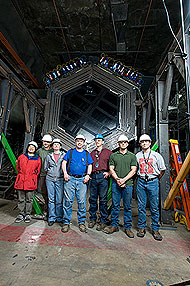MINERvA caps detector with final module
 |
| Members of the MINERvA collaboration pose in front of the detector on Monday, March 15. after installing the final plane. |
Three technicians stood underground last week glancing between a walkie-talkie and a semicircular hole in the ceiling leading 330 feet up to the surface.
"This is the last one," said technician Steve Ruzzano, trying to suppress a smile.
The 120th module of the MINERvA detector was on its way. For about a year, the collaboration for the neutrino experiment had been collecting the 4-ton, hexagonal steel planes into what resembled a horizontal stack of 11-foot quarters in the MINOS near detector hall.
Collaborators first put the idea for such a detector into writing in June 2002, said co-spokesperson Kevin McFarland, who worked on the document.
"This has been the culmination of a huge amount of planning, execution, getting funding, recruiting, hiring people and figuring out how to work together," he said. "To see it all come together and to see the actual detector up there. I have to rub my eyes on occasion."
The crew lowered the planes, each less than 2 inches thick, into the MINOS near detector hall by attaching them to a wheeled frame and rolling them down the flat side of the hole. The crew could see little more than two cables dipping into the shadows from above until the frame crawled into the light about 10 feet above them.
The technicians gingerly caught the frame and attached it to a large, pinkish cart to move it toward the detector. Then they hooked the module to a crane built into the ceiling of the cavern.
The crew slowly rotated the plane into alignment with the rest of the modules, as if closing the final page of a book. As the plane swung into its parallel position, two words written on its face in white grease pencil came into view: "The End."
The collaboration may have reached the end of the detector, but this is hardly the end of the story for MINERvA.
-- Kathryn Grim
View a video of four MINERvA planes being installed.
|